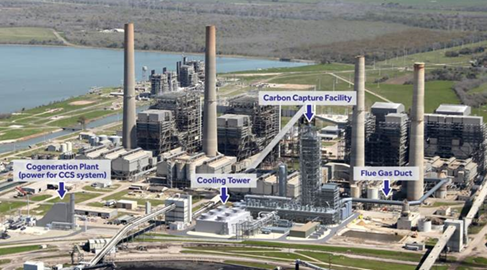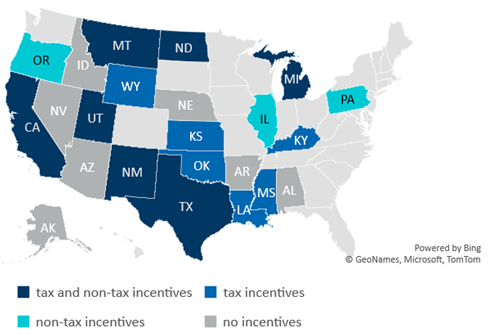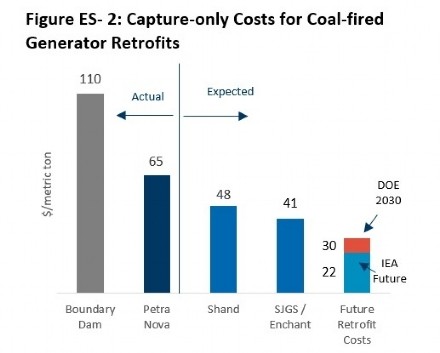Department of Energy and USEA Release Comprehensive Carbon Capture Incentives Report Co-authored by Orrick
September.21.2020
On September 21, the United States Energy Association (“USEA”), on behalf of the Department of Energy Office of Fossil Energy, released a comprehensive report on the current state of carbon capture, utilization, and sequestration (“CCUS”). It details the roadblocks and federal and state tax incentives that aim to smooth the way towards large-scale CCUS adoption and deployment. With CCUS, a key element to energy transition and the race towards zero carbon emission, the stakes are high to find solutions to bureaucratic and economic hurdles.
The report, titled “Review of Federal, State, and Regional Tax Strategies and Opportunities for CO2-EOR-Storage and the CCUS Value Chain” (the “Report”) is the most comprehensive study on the subject and provides a number of solutions and opportunities for market participants. Co-authored by Orrick tax attorneys, Peter Connors and Joshua Emmett, and FTI, a leading consulting group, the report will be the topic of a USEA Webinar on October 1, 2020.
What’s in the Report?
The underlying data makes it clear; the market potential for CCUS in the United States is enormous. With an average CCUS project size of 500,000 metric tons there is potential for more than 6,000 project opportunities. The Great Plains Institute estimates that there are more than 400 near- and medium-term capture opportunities using the Section 45Q tax credit in the United States.[1]

Petra Nova CO2Capture and Sequestration Project Layout
Source: Petra Nova
The report is a complete compendium of federal and state incentives, programs and agencies focused on promoting CCUS, including an explanation of Section 45Q, Section 43 credits, DOE grants and loan programs. It also includes case studies and examples of deal structures anticipated to utilize Section 45Q credits. But roadblocks persist. The authors discuss how government bureaucracy, idiosyncratic or unclear guidelines, market and financial inefficiencies, technical complexities and public opinion are interconnected obstacles that slow large- scale adoption.
What are the Solutions?
Governmental/Regulatory Roadblocks. The Governmental/Regulatory roadblocks exist at the federal and state levels.
- Federal Clarifying guidance will be required for the Section 45Q Credit
- State Expanding or adopting policy programs to support CCUS, such as Renewable Portfolio Standards.
- Other Issues—Long-term Liability Other issues include how to handle the issue of long-term liability for projects that have a lifetime that could be measured in centuries.

States Active in CCUS Incentives
Source: FTI Consulting and Orrick Research
The Public Perception Roadblock. Public Perception is a combination of awareness and positive perception.
- Capture vs Transportation/Storage Concerns. At the component level, studies suggest that transport and storage tend to be more concerning than capture. This concern tends to be around the fear of CO2 leakage from pipelines or storage, which respondents believe could result in the contamination of drinking water, explosion, and/or asphyxiation.
- Communicating with Stakeholders. Studies have been performed to develop strategies for reaching out to stakeholders and improve socio-political, market and community acceptance of CCUS.
Market/Financial Roadblocks. Market/Financial roadblocks center around the levelized cost of energy for electricity generating facilities with a CCUS component. This will be the key to whether CCUS projects will attract investors and developers.
- Tying it all together. The solutions tie into many of the topics discussed in the report, such as regulatory certainty and advancements in technology.

Coal-fired Generation Capture-only Costs
Source: FTI Consulting Analysis
Technical Roadblocks. Technical Improvements will be required to decrease the cost of capturing CO2 below the value of the Section 45Q Credit and other incentives.
- Learning by Doing This will require new technologies and “learning by doing,” or reducing costs and improving efficiency using existing technologies by simply deploying more projects and implementing lessons learned.
For example, reducing governmental and regulatory roadblocks and hurdles that lower permitting costs and timelines would improve the financial and market viability of projects. As more projects become financially viable and come online, learning by doing will increase, resulting in further cost reductions along with an improved public perception of CCUS as a clean-energy technology.
Major solutions to CCUS roadblocks and hurdles will include items such as those listed below.
-
Clarifying IRS guidance on the Section 45Q Credit:
- While existing IRS Guidance provides a safe harbor for tax equity investors in partnerships that capture carbon oxides eligible for the tax credit (“COx”), it does not address the situation where the tax credit is assigned to a party that disposes of, utilizes in permitted applications, or uses the COx in EOR.
- While some guidance on measuring lifecycle greenhouse gas emissions has been provided, reporting procedures and standards for the IRS, DOE, and EPA review of lifecycle reports have not been provided.
- Changing financial accounting guidance, in particular, the required use of the Hypothetical Liquidation at Book Value.
- Making legislative and regulatory changes that accelerate the buildout of CO2pipelines, such as expediting CO2pipeline permitting and development.[2]
- Providing loan guarantees to investors.
- Providing cost-sharing of Front-End Engineering Design (“FEED”) studies.
- Funding of research and development (“R&D”) into advanced technologies such as catalysts, chemical looping, membranes, and solvents.
-
Addressing Class VI permitting and cost challenges:
- Developing a process for delegating primacy to states as the EPA may not have the resources to handle an influx of Class VI applicants.
- Allowing area permits for multiple injection wells instead of a single well.
- Moving to a risk-based assessment of Class VI wells, similar to the statutory standard imposed by the Safe Drinking Water Act.
- Eliminating the 50-year post-injection site care period.
- Allowing monitoring flexibility instead of only direct monitoring, which could create possible leakage pathways.
- Allowing Class V for demonstration projects.
Lowering the barriers to entry by addressing roadblocks and hurdles facing various stakeholders will accelerate CCUS deployment. As a commercially proven technology, CCUS is ready for substantial scale-up and deployment in the United States with the federal Section 45Q tax credit and complementary state incentives providing strong financial support. Project sponsors, tax-equity investors, owners, and operators are ready to tap into federal, state, and local tax and non-tax incentives to bridge the gap of CCUS costs and the market value of CO2.
For additional information regarding the Section 45Q Credit program, see the article linked below.
[1]Abramson, Elizabeth, McFarlane, Dane, and Brown Jeff, “Transport Infrastructure for Carbon Capture and Storage: Whitepaper on Regional Infrastructure for Midcentury Decarbonization,” Great Plains Institute, June 2020.
[2]Utilizing Significant Emissions with Innovative Technologies (USE IT) Act:
https://www.epw.senate.gov/public/index.cfm/2019/2/senators-reintroduce-use-it-act-to-promote-carbon-capture-research-and-development.